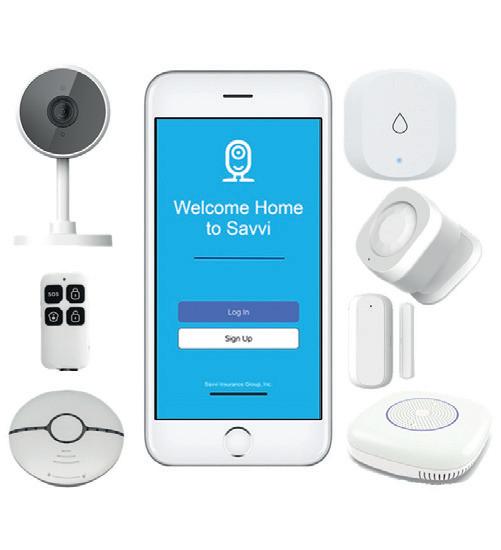
MACHINE LEARNING HOW ACTUARIES BENEFIT FROM AI WITH NOTHING TO HIDE GET READY TO MERGE THE M&A ACTIVITY SHAPING


MACHINE LEARNING HOW ACTUARIES BENEFIT FROM AI WITH NOTHING TO HIDE GET READY TO MERGE THE M&A ACTIVITY SHAPING
’s Jules Ehrlich on better ways to assess risk with voice
PENSIONS PARADOX TECH AND THE UK'S LOST BILLIONS




Moving the dial on trust:
Better ways to assess risk with voice Clearspeed’s voice-based risk assessment technology is a gamechanger for insurers, says Jules Ehrlich, its Chief Product and Strategy Officer. Here, he explains how insurers are using voice analytics to quickly and confidently assess risk across the policyholder lifecycle in ways that streamline the customer experience, accelerate payment of the right claims, and better identify potential fraud
There’s been significant M&A activity in the insurance sector over the past 12 months. Here, we spotlight some notable global takeovers, while insurtech investor Florian Graillot makes the case for mergers and acquisitions being a catalyst for positive change – and often the only choice for growing startups
The pursuit of accuracy
Akur8 Co-founder and CEO Samuel Falmagne is aiming to revolutionise actuarial science with AI that has nothing to hide
It’s estimated that more than £26billion is sitting in UK ‘lost’ pensions. Despite decades of digital progress to give consumers ‘transparency’ on their financial health, that figure is still growing. So, whose problem is it to solve – and how?
Aon is on a mission to unlock data across the insurance chain, as Veronica Judice explains
Recent Gallagher Re figures show that global financing for insurtech startups rose to $1.3billion in Q2.
Fuelled by money going to companies with AI-focussed business models, this represented a five-quarter high in insurtech investment. Emerging technologies such as AI, machine learning, and large language models are changing the landscape. Clearly, the good fight continues to bring the industry kicking and screaming into the digital age and this issue explores some of the best and brightest of those innovations (step forward Clearspeed, Akur8, Aon et al) .
Meanwhile, mergers and acquisitions (M&As) have long-been pivotal strategies for growth, and there have been significant deals, as we discuss on page 8, showing that within this dynamic ecosystem, legacy insurers now recognise they must step up.

Hakbah Founder Naif AbuSaida explains how fintech meets insurtech in Saudi Arabia and opens new markets 4 8





19 21 14 12
Clearspeed
’s voice-based risk assessment technology
is a gamechanger
for insurers,
says Jules Ehrlich, its Chief Product and Strategy Officer. Here, he explains how insurers are using voice analytics to quickly and confidently assess risk across the policyholder lifecycle in ways that streamline the customer experience, accelerate payment of the right claims, and better identify potential fraud
With data and analytics capabilities foundational for insurers, accelerating the customer experience through automation and advanced technologies is a key area to drive improvements and streamline workflows.
Today, insurers can leverage big data and AI capabilities with historical and even real-time information for more insight, but that can bring complexity, increase false positives and may not provide the validation needed to confidently assess risk across the insurance lifecycle quickly and accurately.
Identifying risk today often relies on data that can be inaccurate and incomplete, if available at all, or it’s simply too resource-intensive to effectively parse for true indicators of risk. Organisations are continually evolving their approach to risk assessment, navigating the changing landscape and evaluating if their practices are fast enough and accurate enough to meet the moment.
With an entirely unique approach to analysing voice, Clearspeed provides an assessment of individual risk quickly and with a high degree of precision. This enables better, faster decision-making and remedies the tradeoff between speed and confidence. Providing this real-time

Jules Ehrlich, Chief Product and Strategy Officer at Clearspeed

direct primary measure of human risk is why the United States government and the world’s largest insurance companies are using the Clearspeed platform for risk insight at scale. Our clients are extremely encouraged by the outcomes it’s driving within their organisations, with insurers seeing a massive leap in resource optimisation and an accelerated customer journey after implementing the technology within their workflows.
We believe that trust, and enabling trust, is an insurer’s competitive advantage in a market where it’s increasingly difficult to identify risk and fraud at scale – and easier than ever for bad actors to partake in fraudulent behaviour due to the pervasiveness of sophisticated technology. But what does enabling trust mean in the context of insurance, and, more broadly, our day-to-day lives?
While the risk landscape continues to evolve faster than ever before, one thing remains constant – human nature. Individual risk will always exist and every transaction made requires an assessment of that individual risk, whether making a decision to approve an application, pay a claim, hire an employee, or vet a new supplier.
We call these millions of moments in
a given day in which a decision is made and trust is exchanged ‘trust events’. In these events – where there is an exchange between an insurer and the insured, for example – it is challenging to assess risk quickly and at scale, due to both gaps in current technology and available resources. There’s also a negative impact on the customer experience if you put every customer through an extended verification process and treat them as a bad actor.
Our belief is that it’s possible to fast-track genuine customers while pinpointing only those who require more follow-up, all through identifying risk characteristics in the voice. This is what getting to trust, faster means when you use Clearspeed.
You can think of it like a metal detector at an airport when you go through departures – it doesn’t care who you are or where you’re from, just whether you’re carrying anything made from metal. Clearspeed simply provides a low- to high-risk alert, just like the metal detector. Getting flagged doesn’t mean that you don’t fly, it just indicates the need for someone to follow up. If you’re clear, you’re good to go.
In the same way, low-risk claimants, for example, can move forward quickly, with a straight-through or expedited process that gets them paid faster, while adjusters can focus their
expertise where potential risk is flagged, driving both a better customer experience and a more optimised process for the insurer.
How the platform works
Insurers deliver short, automated voice questionnaires to their customers, connecting with them by phone, app, chatbot or web.
Insurers can choose from the Clearspeed library of questions that have been hugely successful with other insurers or create their own questions, specific to their unique use case.

Using the responses to a set of simple yes/no questions, our proprietary technology maps vocal characteristics associated with risk into a data model. These vocal characteristics are universal to everyone, regardless of language, gender, race, location, credit score, age, or other personal identifiers. Clearspeed analyses and evaluates the questionnaire responses and provides a risk assessment result. This is an entirely new approach to voice analytics.
We believe that trust, and enabling trust, is an insurer’s competitive advantage in a market where it’s increasingly difficult to identify risk and fraud at scale

There are a few essential features to understand with Clearspeed:
■ Automated delivery means that the questions are asked the same way, in the same voice, every time. And it offers consistent around-the-clock availability
■ The questionnaires are language-agnostic, making it easy to accommodate every customer
■ This assessment is objective and unbiased, since we use automated questionnaires and map vocal characteristics associated with risk that are universal to everyone
Insurers have many opportunities to benefit from deploying Clearspeed across the insurance lifecycle, whether at application, underwriting, claim, or renewal stage.
At underwriting, things like smoking or drug use, pre-existing medical conditions, improper vehicle use, or even deficient home conditions may be hidden by applicants in the hope of approval or lower premiums. Risk factors may also appear as fraudulent policy applications with fictitious beneficiaries or duplicate policies. Clearspeed can help uncover risk indicators quickly to enable confident application routing and prevent future claims fraud at the point of application. At claims, insurers rely on a collection of external data sources and prior knowledge of the claimant. This can introduce a form of bias, as the insight is modelled on demographic information and historical behaviours, versus focussing strictly on the individual and a moment in time.
Aggregating and connecting data collected from claim submissions –whether historical or real-time – to gain claims insight can add complexity and may not provide the validation needed to process claims quickly and accurately, contributing to a lengthy and costly investigation service, and, ultimately frustrating customers. And when faced with high claim volumes, the process can’t be consistently expedited without sacrificing thoroughness, accuracy, and a satisfactory level of risk assessment.
Clearspeed solves for this, to triage early in the claims process so adjusters can better identify, prioritise, and route claims – a win when faced with both volume and resource challenges.
Further downstream, an adjuster or special investigation unit (SIU) investigator will relish the precise risk data that Clearspeed provides to inform their next steps. Voice analysis is refreshing with its ability to assess risk, independent of any other data, adding unique insights for a more confident decision-making process, and to complement or enhance insights from existing sources.
A sound approach: Clearspeed gives insurers a new level of assurance
■ Improving the claims experience for genuine customers, including a five-star customer experience rating with inclusion of the Clearspeed questionnaire
This also means insurers can potentially rethink parts of their process. For example, if Clearspeed provides a low-risk score on a low-value travel claim, maybe you won’t bother incurring the time and expense to request a receipt and further review it. Or, you may embed Clearspeed at application to validate and then verify information as it moves through your process to reduce

Insurers have seen significant ROI and resource optimisation using Clearspeed at different points in the value chain, including:
■ Accelerating genuine claims while dissuading the disingenuous with a 40 per cent rise in immediate settlements and 11 per cent walkaway rate
■ Focussed follow-up on claims where risk is evident, with a 50 per cent reduction in average claims handling time
■ Reducing claims leakage, resulting in a 36 per cent lift in average preventative fraud savings per claim and $900 average fraud loss savings per claim
■ Enhancing validation outcomes, leading to a 65 per cent reduction in investigation spend
Insurers have seen significant ROI and resource optimisation using Clearspeed at different points in the value chain

the overall number of steps your genuine customers go through.
In fact, you will absolutely delight your policyholders and Clearspeed will provide a new level of assurance for the decisions your teams are making. Further expediting and automating the customer experience also naturally means lower operating costs. With our clients, Clearspeed is redefining risk assessment with unparalleled accuracy, speed, and simplicity – all by focussing on getting to trust, faster.



There’s been significant M&A activity in the insurance sector over the past 12 months. Here, we spotlight some notable global takeovers, while insurtech investor Florian Graillot makes the case for mergers and acquisitions being a catalyst for positive change, –and often the only choice for growing startups
Not so long ago, Luko was a rising star of French insurtech, backed by $75million from top investors, including Accel and Speedinvest. But in June last year, the online home protection startup filed for bankruptcy.
After a lot of troubled conversations with potential bidders, in January 2024 it was finally plucked from insolvency by Allianz Direct, which immediately got a 45,000-customer foothold in the French online direct insurance market. The acquisition was worth around €4.3million.
So what might this, and other deals, say about the viability of startups, and the insurtech industry, in general? According to Florian Graillot, founding partner at early-stage insurance fund astoryaVC, the acquisition of Insurtech startups by established players is a trend that’s set to continue.
“In fact, I believed we would see a lot more [this year],” says Graillot. “There is a natural cycle. This is the end of the first wave; startups are now having to make decisions about how they will – or can – operate in the future.
“Perhaps some companies simply want to buy their opposition to increase their footprint or sustainability. But more often than not, these companies are facing choices.
“If they are profitable – fine. If not, do they have a plan B for reducing their costs, for reducing their runways? If so, they can also continue. If not, however, there is a stark choice – either go bankrupt or consider an M&A.”
For Graillot, in all likelihood, it ultimately comes down to one thing – cashflow.
“If a company is profitable, it doesn’t need money – or if it does require more, it’s easier to try and raise it,” he adds. “For many founders who don’t fit into that category – and who can’t reduce their costs at significant enough rates – an M&A is a tough but inevitable option.”
That said, M&As are not necessarily an admission of defeat. Instead, they represent an opportunity for founders and corporates alike to improve their offerings. Citing Akur8’s acquisition of Arius Reserving Solution, which allows the former to enjoy the latter’s US market access, Graillot says M&As will herald a new frontier of change.
“I believe the second wave of transformation in the sector is linked to digitalisation through acquiring startups,” he says. “Ultimately, there is a dual dynamic: startups seeking avenues for development, and corporates embracing technology to maintain relevance in the
evolving insurtech landscape. These corporates are benefitting, in many cases, from acquiring nice portfolios or assets and also enhanced technology with a better user experience.
“Insurance is notoriously slow to embrace change – we are not that far ahead of where we were 10 years ago, unfortunately – but with all this in mind, I would say that these M&As should help speed up the journey of transformation. There are exciting times ahead, I hope.”

Top of the deal table, Zurich’s $670million acquisition of Kotak General Insurance in June of this year represented the largest foreign investment in India’s general insurance market and the first by a foreign insurer since the foreign direct investment (FDI) limit was raised from 49 per cent to 74 per cent in 2021.
Kotak General Insurance offers ‘customised products and services’, leveraging ‘state-of-the-art technology and digital infrastructure’, according to the announcement.
The deal, which saw Zurich acquire 70 per cent of the business, now rebranded as Zurich Kotak General Insurance, is aimed at capitalising on the projected growth of the general insurance market in India.
Fuelled by economic prosperity (India is expected to become the third-largest global economy by 2030), regulatory support and an expanding middle class more willing to embrace the value of insurance, Zurich predicts that it will raise its headcount in India by 40 per cent over the next three years.
These corporates are benefitting, in many cases, from acquiring nice portfolios or assets and also enhanced technology with a better user experience

DEAL VALUE: Not disclosed
REGION: UNITED KINGDOM
In August, Australia’s AUB Group Limited announced a significant expansion into the UK insurance market by acquiring an 80 per cent equity stake in the Movo Group.
The Movo Group integrates a broking portfolio, an authorised representative network, and the insurance technology platform Durell Software, which is a provider of proprietary software for policy administration and front-office applications that handles more than £270million in gross written premium and serves around 189 clients, including 120 brokers.

DEAL VALUE: Not disclosed
REGION: AUSTRALIA
In June, Chubb announced that it had acquired the Melbourne-based managing general agent that specialises in general aviation insurance for the Australian market. Chubb said that the acquisition would complement its existing aviation operations, such as Chubb Global Markets in London and the aviation hub established in Singapore in 2023, and help fulfil its ambitious plans in Australia and New Zealand.

DEAL VALUE: $600million
REGION: GLOBAL
This summer, AIG sold its global personal travel insurance and assistance business, AIG Travel, to Zurich in a deal worth more than $600million.
The business will be combined with Zurich’s travel insurance provider Cover-More Group, which focusses on digital transformation and travel risk management.
Cover-More says: “We deliver technology platforms and back our technology up with a team of digital optimisation architects, and CX specialists with the experience, knowledge, and insights proven to increase yield and add real value to customer-facing offerings.”
The deal will make Zurich one of the leading travel insurers in the US and around the world.
Within their grasp Corporates are looking for quick progress through M&A



DEAL VALUE: $300million
REGION: UNITED STATES
In April, Chubb announced that it was acquiring Healthy Paws, a US-based managing general agent specialising in pet insurance, from Aon plc. Since 2013, Chubb has been the exclusive underwriter for the Healthy Paws pet insurance programme, which protects more than 500,000 dogs and cats across the US. Healthy Paws provides programme and claims administration via a digital proprietary platform.
Chubb said the $300million deal will allow the business to ‘amplify the impact of this esteemed pet insurance brand in a vastly underpenetrated market’.

DEAL VALUE: Not disclosed
REGION: UNITED STATES
Next-generation insurance pricing insurtech Akur8 acquired US reserving solution provider Arius from Milliman in September, to bolster its actuarial platform and extend its global footprint.
Arius is a property and casualty reserving software, utilised by insurers and reinsurers to manage risk and enhance financial performance. Known for its innovative tools and methodologies, Arius is used by 150 insurance and consulting clients, with more than
1,500 users. It followed up the Arius deal by successfully completing a £120million Series C funding round.


DEAL VALUE: Not disclosed
REGION: CANADA
Axis Insurance, an award-winning full-service brokerage offering a range of commercial, life, employee benefits, and wealth advisory services, announced that the O’Neill Group would become part of its business in September of this year.
O’Neill Group is one of British Columbia’s premier providers of employee group benefits, life insurance, and wealth advisory services.
Axis, based in Vancouver, said the purchase ‘continues to build upon our existing benefits practice, and positions Axis Insurance well on its journey to become a leading national specialty brokerage’.
This year, Axis has embarked on an aggressive expansion programme, acquiring several other brokerages in the region.


DEAL VALUE: Not disclosed
REGION: AFRICA
A leading supporter of African startups, in September telecoms giant Axian Group became the second-largest shareholder in
WiASSUR, an innovative early-stage insurance provider, based in Côte d’Ivoire.
WiASSUR, a 100 per cent digital insurance broker, offers a range of insurance products, including auto, health, life, travel, and home insurance, with its B2B2C business model aiming to make insurance more accessible to African consumers via an online platform.
Axian said it aligned with its goal of accelerating digitalisation and financial inclusion across Africa.

DEAL VALUE: Not disclosed
REGION: UNITED KINGDOM
UK pensions data firm ITM was acquired by European life and pensions insurtech Lumera in July.
ITM is a data management and technology solutions company working with many of the UK’s largest pension funds. As an integrated service provider (ISP) it has been at the forefront of dashboard development in the UK, and offers a broad range of services to support UK pension customers.
Lumera says the deal will add to its offering in new markets, including “tech-enabled specialist services for data analysis, regulatory compliance assessments, de-risking and liability management, platform data migrations, data quality management, data cleansing and tracing”.







Akur8 Co-founder and CEO Samuel Falmagne
is aiming to revolutionise actuarial science with AI that has nothing to hide
There is a mixture of optimism and caution about the role of AI in many industries, but one area that it seems destined to revolutionise is the actuarial function. After all, actuaries and AI share the same lifeblood: data.
Gathering it, analysing it, offering strategic recommendations based on it, and making the resulting insights clear and digestible is what actuaries do, day in, day out. Coupling their human expertise with increasingly powerful artificially intelligent tools potentially unlocks
huge opportunities. And nowhere is there a bigger concentration of actuarial skill than in the insurance industry.
It’s here, where the financial cost of risk and uncertainty is constantly weighed in the balance, that Akur8 has focussed its ambition. Fresh from a funding round, and with a new foothold in the US, thanks to its acquisition of the award-winning P&C reserving software Arius, Akur8 has expanded to 160 people, with clients in more than 40 countries, since it was incorporated in 2019.
Co-founder and CEO Samuel Falmagne hadn’t come from an insurance background, but it was the opportunity for innovation in the sector that excited him.
“I had a pretty long career in tech, at IBM, then I moved to an insurtech. I could see the potential of this industry in terms of disruption,” he says. “Insurance is a heavily
challenged industry at the moment and needs to reinvent itself.”
That’s not lost on the big players, but it's a colossal job, making it an appealing marketing for startups like Aku8 with targeted solutions.
"When we started, a lot of domains within insurance were still untouched with very low technology adoption,” says Falmagne. “It’s also quite a stable industry economically that doesn’t suffer too much from macroeconomic changes – at least less than other industries – providing large, stable clients.”
Although entrenched attitudes in these legacy institutions may make them difficult to penetrate at times, there is a general acceptance that the prize is worth the pain. Investors certainly think so. A report from Gallagher Re found that funding in global insurtech saw a 39 per cent surge during Q2 of 2024 to reach £992million ($1.27billion).



COVID accelerated those changes. This pushes insurers to launch new products and evolve historical products.”
More innovative products and pricing models have a direct impact on the actuarial function. Take the case of a UK life insurer that now offers a product which monitors policyholders’ health and dietary habits, rewarding them with lower premiums with reduced underwriting. This gives policyholders broader coverage while making higher protection levels more affordable. Not only do the figures show that clients stay healthier, but there is also a significant reduction in policy lapse rates.
As data collection methods evolve to support these kinds of products, the pressure to adopt machine learning in the actuarial process increases.
Falmagne points out that the insurance industry is in a privileged position when it comes to, not only how much data it gathers, but when it collects it.
“Even before someone becomes a client, they’ve already shared a lot of it with you,” he says. “That is very different from other industries.
“If you look at retail, air travel, pharmaceuticals, you only start getting to know your client once they’ve signed up, perhaps by analysing their use of a loyalty card. Before that, you have relatively little information on them.
“In insurance, however, customers are asked a lot of questions during the onboarding process. There’s
Machine learning and AI can only be used in insurance if there is a very high level of transparency around what’s produced by the algorithms
It’s a refreshingly large jump after previous investment slumps.
“The risks in insurance are changing much faster than before,” explains Falmagne. “That is driven by climate change and by new technologies, such as electric and autonomous vehicles. You also have global inflation and other external drivers, which contribute to the pace of change.
“Clients’ needs are evolving, too, and people are behaving differently –

a huge opportunity to make better use of those significant volumes of data.”
Adding more human resources to process it is simply not financially viable – maybe not even physically possible.
“AI and machine learning can be really transformational, to support the industry to make better use of all the data that it is collected, allowing insurers to react faster to market changes and client expectations,” says Falmagne.
“By applying machine learning to the process, the user can make better informed decisions.”
That last part is important. Although AI’s impact on jobs is a legitimate concern here, as elsewhere in industry, Falmagne believes roles will not be lost so much as evolve in insurance. Analysts at EY tend to agree. They say there will be ‘growing demand for candidates with a blend of traditional actuarial skills and expertise in data analytics/AI’.
“I think the necessity for human involvement is one of the safeguards [against job losses],” says Falmagne, “but that means there needs to be some level of transparency in AI and machine learning technology.”
Indeed, he would go so far as to say that ‘machine learning and AI can only be used in insurance if there is a very high level of transparency around what’s produced by the algorithms’.
It’s important not only from an operational, but also a regulatory point of view.
“As soon as something has a black-box effect there is a risk that the regulator won’t accept you because, in each geography, there are pricing factors that you cannot use,” explains Falmagne.
Akur8’s solutions are based on this principle of full disclosure.
“We wanted to bring machine learning to the table, but keep full transparency and control over the models created,” he says.
“Actuaries are manipulating a lot of data. By using machine learning in those use cases, we can support them to do their job faster.
“We started with pricing use cases and recently expanded into covering reserving through our acquisition of Arius. We now leverage newer technologies such as software-as-a-service, the Cloud, and machine learning at each step of the process, whenever it makes sense to do so, ultimately allowing users to focus on decision-making.
“What started as one module has expanded to many but with the same vision of building a fully integrated actuarial platform and leading this domain within insurance.”

In the UK, it’s estimated that more than £26billion is sitting in ‘lost’ pensions. Despite decades of digital progress to give consumers transparency on their financial health, that figure is still growing. So, whose problem is it to solve – and how?
October in the UK is Lost Pensions Month, when consumers are encouraged to rummage down the back of the financial services industry sofa for a missing £26billion in retirement savings.
How could we have been so careless? And why, in a digital age, is that stash of obscured cash still growing?
Savers themselves can be held partly responsible. Research carried out for the government in 2023, revealed that public attitudes to pensions could be summed up in three words: ‘detachment, complacency and fear’.
“That’s partly why I’m passionate about pensions dashboards,” says Richard Smith, the voluntary chair of the Pensions Dashboards Operators Coalition (PDOC), an industry-led body, set up earlier this year to accelerate development of the technology, infrastructure and standards. “I don’t feel good that I have spent 35 years in a sector that has so little street cred.”
That’s a little hard. After all, working patterns have changed radically in three decades. Boomers were the first to reject the idea of a job for life; Gen Zers are predicted to have as many as 12 jobs over multiple careers. Which makes it even more urgent that

they’re able to track pots of retirement cash quickly and easily.
“Changing jobs means leaving behind an old workplace pension if you were auto-enrolled, and if you change jobs frequently those pensions may be relatively low value,” points out Rebecca O‘Connor, director of public affairs at PensionBee. “The temptation is then, when you lose track, to let it slide, but actually it all adds up and a pension that was worth £2,000 when you were 25 could end up being worth an extra £10,000 when you retire. ”
And with 30-40 per cent of working adults not paying in enough to give them a decent standard of living when they take it out (according to research in August for the government’s Pension Review), they certainly can’t afford to ‘lose’ any of it.
“We don’t yet have an easy solution for the lost pensions problem in the UK, despite the pensions dashboard programme, which is taking forever, and despite fintech, which, in theory, makes solutions to such problems easier,” says O’Connor.
Some of the UK’s closest neighbours, culturally and geographically, are way ahead of us in building the digital architecture and regulatory framework needed to not only keep track of
retirement funds, but motivate savers to actively take an interest in them.
Denmark was the first to launch a single, government-run portal, through which consumers can view and manage all their pension pots. The Netherlands, Belgium and Sweden offer a similar public service. Norway took a slightly different approach. Its government set up a central data retrieval gateway into which commercial dashboard operators, such as personal financial management
We don’t yet have an easy solution for the lost pensions problem in the UK
Rebecca O'Connor and banking apps, connect through APIs, triggering a one-time request for information from pension providers.
Perhaps it’s no great surprise that the average Norwegian checks in on their pension 10-times a year, compared to once or twice a year in countries where the information is only available through a single dedicated interface.


It’s the Norwegian-style system that Capgemini is currently building for the UK government under the Pensions Dashboard Programme, which will be managed by the Money & Pensions Service. Starting in April 2025, all pension providers must have the systems in place to respond to data requests initiated by savers using the Gov.uk One Login, sending a prescribed package of information back to the dashboards. That will, finally, reveal just what we’ve got and where… at least, that’s the theory.
As Smith says: “There are 100 billion pension investments across 3,000 providers that have been built up across decades. The big question mark is over the quality of the data. But all of the pension providers are investing more than I have seen over the past 30 years to get ready for this.
“They need three things – a technology partner to build API connections; to be able to respond to ‘find‘ requests; and they have to be able to send a prescribed set of data back to the customer. And it all requires pension records to be correct. The challenge will be the quality of data-matching done by the provider.”
Up until now, says PensionBee’s O‘Connor, there has been ‘some intransigence and some difficulty with gathering data from older legacy pension books’.
“It shouldn’t be this hard, but it is,” she says. “It’s fair to say some parts of the industry are more invested in keeping things the way they are rather than enabling people to have full visibility and control. To be able to see all of your pension details in banking apps would require pension providers to share and integrate that data with other institutions.
Currently they don’t have the commercial incentives to pursue this. This is why pensions dashboards are, in theory, a good idea.”
Under the new rules, which must be fully adopted by autumn 2026, institutions will have no choice but to release the data. Commercial platform providers like PensionBee and Moneyhub, who have already joined the PDOC alongside some of those major pension providers, are keen to develop the APIs and earn their pension dashboard operator’s licence from the Financial Regulation Authority.
But the Money & Pensions Advice Service’s consumer-facing MoneyHelper, which will act as the government’s own dashboard, will likely be the first to go live.
“As in Norway, I think it’s important that there is what you might call a ‘BBC of pension
dashboard operators’ to instil trust, the ones that anyone can go to without an app,” says Smith.
Auto-enrolment, generally seen as a success in the UK, ensured that employees were at least contributing to a pension after 2012. But it requires nothing to be done on the part of the saver, except sacrifice pay through the payroll scheme.
“A lot of people don’t even know they are enrolled," says Smith. “Digital engagement with the employer’s pension provider has been very low – less than one in 10.”

The concept of pension dashboards is based on the same saver inertia.
“Pension dashboards are designed on the premise that most people do not know where their pensions are – so you just press a big search button and the industry does all the heavy lifting for you,” says Smith.
The light fantastic: Lost pensions need to come out of the shadows
“Consolidation in the sector will help to promote value for money and should ultimately help to simplify pensions, too,” says O‘Connor.
Smith points to another important change in legislation, the UK’s Consumer Duty Act, which will force pension providers to sweat data to understand more about individual customers and respond to their needs appropriately, says Smith.
Take the example of two women with £1,000 each in a pension, one with a mortgage paid off in full, married and with income from additional investments, and one single and in rented accommodation with no other financial assets. Currently, the optics on those customers mean providers treat them identically when clearly their retirement planning needs are very different. In Australia, in fact, government mandates that pension providers gather just such third-party information on customers to give them a holistic picture of their retirement needs.
For O‘Connor, change is long overdue. “The problem of lost pensions should have been solved years ago,” she says. “The governement’s Pensions Review is also a great opportunity to focus on value for money for savers and place retirement outcomes front and centre of future policy changes. The big risk is that the interests of UK plc in using pension funds for growth are put first and this could be to the detriment of savers, if value for money isn’t also prioritised. This will involve a strong focus on potential returns but also keeping asset management costs down”.
All the pensions providers are investing more than I have seen over the past 30 years to get ready for this
But it’s at that point, when savers can see exactly how their retirement plans are panning out (or not) – in the same app that they use to do their everyday banking or manage their budgets – that Smith predicts there will be a sudden demand for additional information, services and support. Chief among those is likely to be more demand to consolidate pension pots to make investments work harder for savers. It will also reduce the number of very small, expensive-to-maintain investments that are lying – often ‘lost’ and unloved –across the industry.

Richard Smith
For a package of reforms that could have such a fundamental impact on the quality of millions of people’s (generally much longer) lives in retirement, there has been very little communicated so far to the average job-hopping Gen Zer, building up pots of pensions in their wake, nor the wider the financial services industry that will be touched by the consequences.
The UK’s experience with open banking, with its disappointing rates of adoption six years after its introduction, has shown that it requires sustained, simple messaging when it comes to driving change among consumers, while industry needs commercial incentive. And, as Smith points out: “This is way bigger than open banking.”














5 Zones:








Veronica Judice, Managing Director – Client Solutions at Aon

Aon is on a mission to unlock data across the insurance chain, as Veronica Judice explains
“Data analytics is central to our strategy. We really believe that power is in the data, and that knowledge is in the data and experience.”
So says Veronica Judice, who heads up the claims practice of Aon’s Strategy & Technology Group (STG), and leads on claims transformation for the reinsurance giant. Her job is to find ways to optimise the claims operations using digital technology. It’s not a solitary pursuit. Rather, it involves everyone, from reinsurer to distributor to broker to ultimate client, and includes broker/ client data, underwriter data, claims data, and third-party administrators’ data – all of it often in different formats.
“It is a consulting process, we listen to our clients to understand their changing needs and leverage on data to meet those needs,” says Judice. “One of the challenges that insurance is facing right now is that there is an enormous amount of data that’s not necessarily shared among industry stakeholders. If we could improve sharing the data, that would give us a better picture of what’s going on, lessons learned that turn into a prediction of how things could go [in the future]. And that would bring clarity and confidence to make better decisions and improve risk management.
“What we’re trying to do is ensure the market can use the vast amount of data we have to resolve the clients’ needs.”
It’s not that the sector is financially challenged, stunting innovation –today’s healthy reinsurance market ‘presents opportunities for insurers to leverage reinsurance capital to support growth plans, manage volatility and/or alleviate capital constraints’, according to Aon’s mid-year Reinsurance Market Dynamics report.
But sharing unified data is nevertheless proving a challenge, says Judice. The industry comprises not only a patchwork of disjointed, disparate data, but also a mindset that’s difficult to change in some areas.
Aon put as much thought into managing its human capital as its technology estate when it introduced its Strategy & Technology Group in late 2022 to bring together insights and software solutions to help reinsurance clients build flexible and resilient enterprise structures.
There’s so much data but it comes from different sources. How do we make it more uniform to support claims processes?
“We use data to create insights and thus monitor and improve process performance and product, helping clients shape better results,” says Judici.
But the whole industry is still in the foothills of transformation when it comes to feeding those workflows with the information it needs, adds Judice, who has been with Aon for around 10 years.
“We have so much data, but it comes from all different sources. So how do we make it more uniform and consistent to support claims processes? That is what we are working on now, and what, I think, the entire insurance industry is trying to work at now. If we just could put the data together in a more organic way and look at it more holistically, we could really improve the use of it.”
Originally from Milan, Veronica Judice studied business and economy at university before moving to law school in Italy. She finished her qualification in the US where she sat her exams for the Bar in New York.
Judice says she took law because she wanted to make a difference to people’s lives. But, having practised in the insurance industry, she realised that it had an equally big impact on economies, businesses and individuals. Her career at Aon started in claims before working on strategy with insurance carriers within Aon and later returning to the claims arena.
“I focus on commercial insurance,” says Judice. “We deal with the carriers that are our reinsurance clients, but it all trickles down to individuals. It has a tangible impact on people’s lives and the economy in general. And I really like that.”


Naif AbuSaida explains how wealthtech meets insurtech in Saudi Arabia and opens new markets
As an expression of his, and his country’s, ambition to transform the Saudi Arabian economy, in 2016 Crown Prince Mohammed bin Salman announced the publication of Saudi Vision 2030.
The document set out a long-term strategy to bolster the country’s fiscal position and diversify its economy from one that relied heavily on its natural resource of oil by the year 2030.
The transformation would create a ‘vibrant society’ through urbanisation, culture and entertainment, and laid out plans to encourage foreign investment, empower women in the workforce, and foster international competitiveness. It also led to the creation of the Financial Sector Development Programme (FSDP).
The FSDP has become the cornerstone of the financial sector in Saudi Arabia over the past six years, promoting income diversification, boosting savings, and offering various financing and investment opportunities. The government itself has stated: “The programme is strengthening financial

Naif AbuSaida, Founder at Hakbah

sector institutions, advancing the financial market, encouraging savings, and fostering the growth of fintech startups in their pursuit of a world-leading financial sector.”
It created opportunities to tackle many areas where financial provision was lacking or products and systems could be improved: including addressing something of a savings crisis.
The provision of free healthcare for all in the Kingdom and the social safety net of families providing for each other in times of need meant that saving was not a cultural habit. The figures make stark reading – 70 per cent of Saudi citizens lacked emergency savings, and the percentage of households saving regularly was just 1.6 per cent.
So it is within this dynamic that one fintech, Hakbah, came up with the idea of digitising ‘jameya’ – the discipline of ‘social saving’, commonly found in countries with strong family or tribal relationships, where members regularly contribute money to a common pot, with each taking turns to receive a lump sum from it.
Crucially, there is no payment of interest, as interest, or ‘riba’, is not permitted under Sharia law.
Founded in late 2018 by Naif AbuSaida, and launched in the summer of 2020, Hakbah is an alternative savings platform with its first product, a mobile app for groups of family or community-based savers, now boasting more than 800,000 users. Some 70 per
cent of these are between 21 and 35 years old. The platform has helped 80,000 customers save more than US$200million combined.
AbuSaida explains the genesis of the platform: “We looked at how people do savings traditionally, and one way is via groups,” he says.
“These savings groups exist in different parts of the world and are called different things – the general term for them is ROSCAs (Rotating Savings and Credit Associations) – but they all operate in largely the same way [members all chip in regularly and take turns withdrawing accumulated sums].
“We wanted to build on those systems, encourage the ‘habit’ of taking part and use digital to drive the whole process.”
AbuSaida believes that the success of Hakbah is also very much down to the fertile environment that fintechs now find in the country.
“The target, based on the FSDP, was for 525 fintech startups to exist by 2030. Today, we are already at 224 fintechs, exceeding the H2 2024 target of 168. And that is because of the ecosystem,” he says.
“The digital infrastructure in Saudi Arabia is more advanced than Europe, US, or any other country. You can buy something via a mobile app and have it delivered the next day. You can do your entire loan or mortgage online. You can also attend a court virtually with a judge. Everything is digital here.”

Saudi Arabia has a 99 per cent internet penetration rate and one of the fastest mobile internet speeds in the world, at 215 Mbps.
“This is part of the enablement from the government, for whom innovation is very, very important,” says AbuSaida.
“We go into meetings with them and they approve what we have presented, but then they ask ‘is that all? What else do you have?’ So, we then take them through what we are working on for the future. They give us initial approval, encourage us to officially start it and apply for final approval. It’s an exciting space to be in at the moment.”
Collaboration is key Hakbah’s strategy involves forming alliances with industry leaders like Riyad Bank, Fransi Bank, ANB and low-cost airline Flynas. In September of this year, it announced another –with Tawuniya, the leading insurance company in Saudi Arabia.
This collaboration provides Hakbah’s customers with comprehensive life insurance coverage during their jameya savings cycle. Extensive benefits include coverage for death by any cause and ‘passive war risk’. The enhanced financial security is designed to eliminate concerns related to unexpected future events and how that might impact other members of the family.
The two products from one provider align perfectly with Vision 2030 in supporting the Saudi government’s goal of increasing savings rates and promoting financial inclusion. It’s also Hakbah’s mission – ‘to empower individuals and drive positive economic change’ – according to AbuSaida, whose LinkedIn profile backs that up. His personal tagline is ‘shaping the future’. Making the case for insurance is hard in Saudi Arabia. As in the UK, health care, free at the point of delivery, extends to everyone, so only the wealthy take out health policies. In times of crisis, the cultural norm anyway is for family or tribe to rally round.
And when it comes to life insurance, for some time it was thought to be incompatible with Shariah principles. It’s not, says AbuSaida, but it’s held it back and with ‘too many industries,
domains or verticals still not covered by insurance’, he believes it needs a trusted intermediary to introduce them.
“Sharia compliance and life insurance can work for Muslim society, but how many people have life insurance? The culture is not there,” he says.“So wealthtechs like ourselves have a great opportunity to play that role as an agent, if they have a strong proposal, including risk, customer protection, financial innovation, and social impact.
“The first thing we did when we partnered with Tawuniya was give life insurance to all our customers for free for the duration of the savings group, linked to the total amount saved. So if you join the savings group with a 50,000 or
fit. Here, fintechs have a great opportunity to complement a big insurance company’s offering right at the start of the journey.”
In Hakbah’s case, bolting life insurance onto a culturally familiar financial product like jameya was the key to unlocking a new market for its insurance partner.
“We designed a product from the beginning to be aligned with the behaviour and psychology of people,” says AbuSaida. “People just like to help each other. In the savings group, every month, a human being with their financial need – regardless of whether they are a housewife, student, employer or whoever – is given help, and that is

60,000 riyal savings bond, you have this policy for the duration of the savings. Whatever happens to you, your family will not suffer.
“This is just an entry point. Insurance companies like it because overnight they will increase their customer base with Hakbah customers. And they can renew the insurance either direct with the insurer or within Hakbah.”
Tech can’t hope to change the insurance industry here or elsewhere, says AbuSaida, unless the tech builders really understand the nature of insurance and the community in which it’s being offered.
“It doesn’t require only an app. You need to get to grips with the fundamentals,” he says. “Life insurance, for example, in Saudi Arabia is an area where insurers don’t have good penetration because culturally it is not a
We enjoyed organic growth with zero advertising spend. It was pure word of mouth because we touched what people really wanted

powerful. You are doing good with your money without losing your money. And this means that people tell other people about their experience, without there being a financial incentive or reward.
“Because of that, we enjoyed organic growth with zero dollars spent on advertising. It was pure word of mouth because we touched what people really wanted.”

Looking to multiply your premium? We can help.
Learn how you can write premium, not code.
With INSTANDA, Savvi Insurance combined innovative homeowners insurance and smarthome technology to revolutionize risk prevention, and ultimately double their premium month-over-month.
Smart home insurance Peace of mind included
